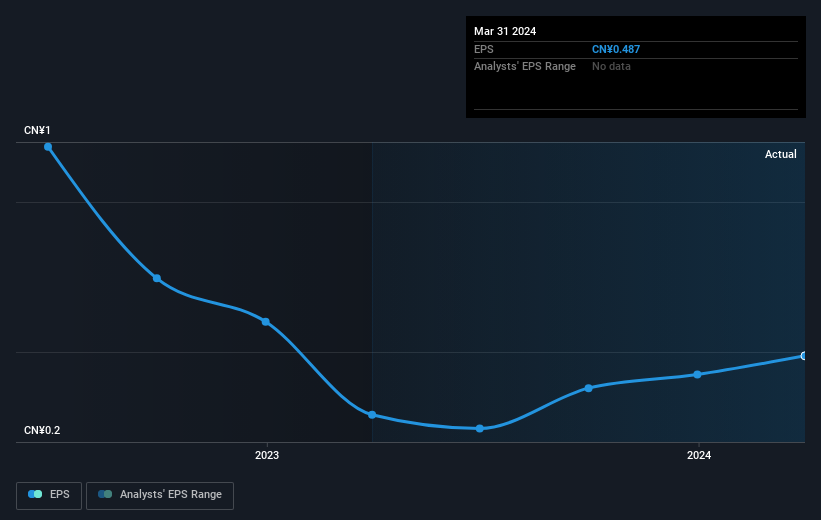Stock Analysis
The three-year shareholder returns and company earnings persist lower as Shanghai Huayi Group (SHSE:600623) stock falls a further 3.9% in past week

One of the frustrations of investing is when a stock goes down. But when the market is down, you're bound to have some losers. The Shanghai Huayi Group Corporation Limited (SHSE:600623) is down 17% over three years, but the total shareholder return is -9.7% once you include the dividend. And that total return actually beats the market decline of 18%.
If the past week is anything to go by, investor sentiment for Shanghai Huayi Group isn't positive, so let's see if there's a mismatch between fundamentals and the share price.
View our latest analysis for Shanghai Huayi Group
While markets are a powerful pricing mechanism, share prices reflect investor sentiment, not just underlying business performance. One flawed but reasonable way to assess how sentiment around a company has changed is to compare the earnings per share (EPS) with the share price.
During the three years that the share price fell, Shanghai Huayi Group's earnings per share (EPS) dropped by 5.4% each year. This change in EPS is reasonably close to the 6% average annual decrease in the share price. That suggests that the market sentiment around the company hasn't changed much over that time, despite the disappointment. Rather, the share price has approximately tracked EPS growth.
The image below shows how EPS has tracked over time (if you click on the image you can see greater detail).

It might be well worthwhile taking a look at our free report on Shanghai Huayi Group's earnings, revenue and cash flow.
What About Dividends?
It is important to consider the total shareholder return, as well as the share price return, for any given stock. Whereas the share price return only reflects the change in the share price, the TSR includes the value of dividends (assuming they were reinvested) and the benefit of any discounted capital raising or spin-off. So for companies that pay a generous dividend, the TSR is often a lot higher than the share price return. We note that for Shanghai Huayi Group the TSR over the last 3 years was -9.7%, which is better than the share price return mentioned above. And there's no prize for guessing that the dividend payments largely explain the divergence!
A Different Perspective
It's good to see that Shanghai Huayi Group has rewarded shareholders with a total shareholder return of 9.6% in the last twelve months. Of course, that includes the dividend. Notably the five-year annualised TSR loss of 0.5% per year compares very unfavourably with the recent share price performance. We generally put more weight on the long term performance over the short term, but the recent improvement could hint at a (positive) inflection point within the business. I find it very interesting to look at share price over the long term as a proxy for business performance. But to truly gain insight, we need to consider other information, too. Take risks, for example - Shanghai Huayi Group has 2 warning signs we think you should be aware of.
But note: Shanghai Huayi Group may not be the best stock to buy. So take a peek at this free list of interesting companies with past earnings growth (and further growth forecast).
Please note, the market returns quoted in this article reflect the market weighted average returns of stocks that currently trade on Chinese exchanges.
Valuation is complex, but we're helping make it simple.
Find out whether Shanghai Huayi Group is potentially over or undervalued by checking out our comprehensive analysis, which includes fair value estimates, risks and warnings, dividends, insider transactions and financial health.
View the Free AnalysisHave feedback on this article? Concerned about the content? Get in touch with us directly. Alternatively, email editorial-team (at) simplywallst.com.
This article by Simply Wall St is general in nature. We provide commentary based on historical data and analyst forecasts only using an unbiased methodology and our articles are not intended to be financial advice. It does not constitute a recommendation to buy or sell any stock, and does not take account of your objectives, or your financial situation. We aim to bring you long-term focused analysis driven by fundamental data. Note that our analysis may not factor in the latest price-sensitive company announcements or qualitative material. Simply Wall St has no position in any stocks mentioned.
About SHSE:600623
Proven track record with adequate balance sheet.

